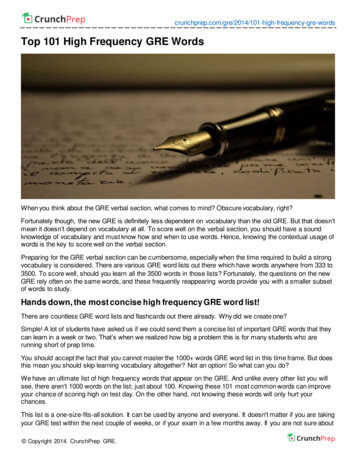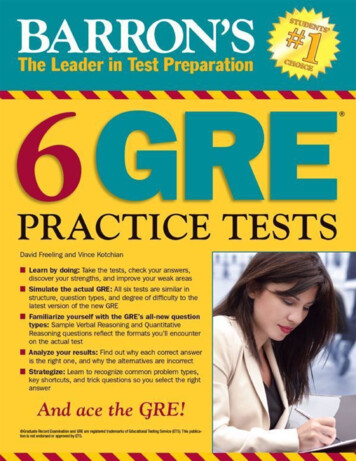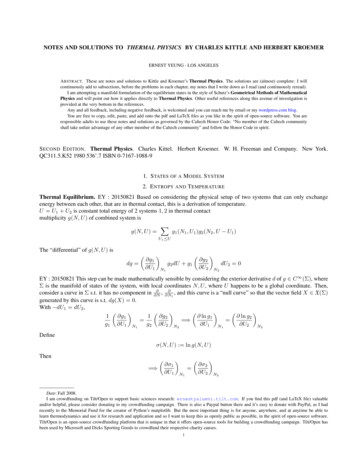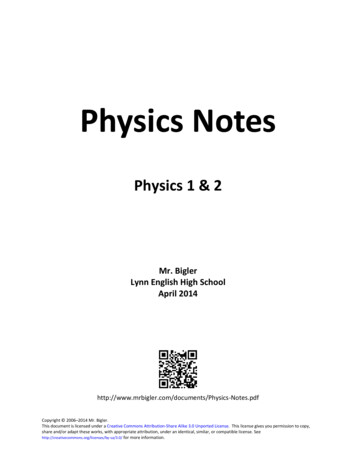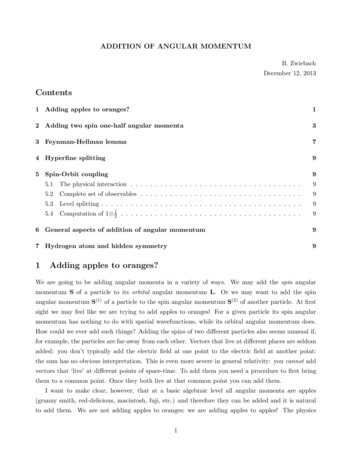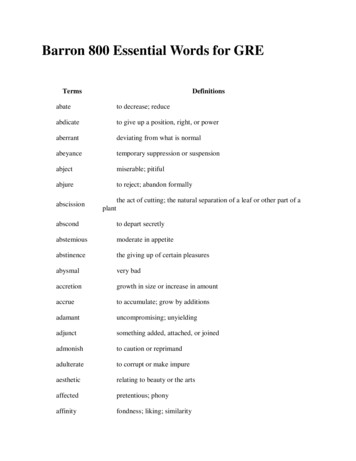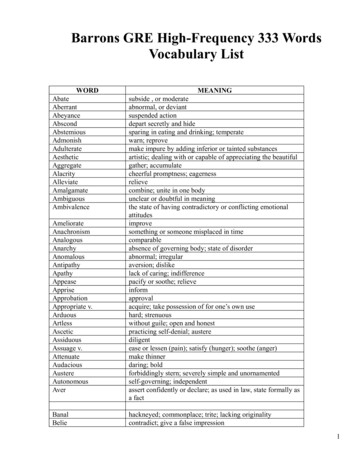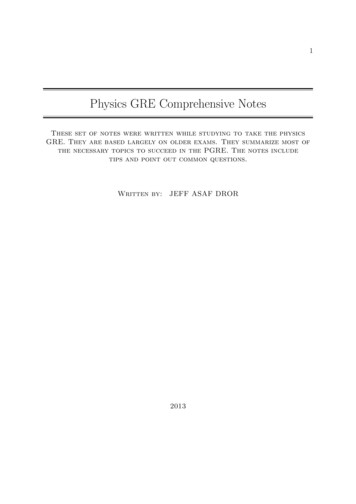
Transcription
1Physics GRE Comprehensive NotesThese set of notes were written while studying to take the physicsGRE. They are based largely on older exams. They summarize most ofthe necessary topics to succeed in the PGRE. The notes includetips and point out common questions.Written by: JEFF ASAF DROR2013
Contents1 Preface2 Classical Mechanics2.1 Newton’s Laws . . . . . . . .2.2 Forces . . . . . . . . . . . . .2.3 Projectiles . . . . . . . . . . .2.4 Springs . . . . . . . . . . . . .2.5 Systems of Particles and Rigid2.6 Collisions . . . . . . . . . . .2.7 Rotational Motion . . . . . .2.8 Non-Inertial Rotational Forces2.9 Orbits . . . . . . . . . . . . .2.10 Fluids . . . . . . . . . . . . .2.11 Waves . . . . . . . . . . . . .2.12 Eigenmodes . . . . . . . . . .2.13 Sound in a Pipe . . . . . . . .2.14 Rocket Motion . . . . . . . .2.15 Lagrangian Mechanics . . . .7. . . . . . . . . . . . .Bodies. . . . . . . . . . . . . . . . . . . . . . . . . . . . . . .3 Electromagnetism3.1 General Knowledge . . . . . . . . . . . . . . . . . . .3.2 Magnetization and Polarization . . . . . . . . . . . .3.3 Maxwell’s Equation . . . . . . . . . . . . . . . . . . .3.4 E Field Due to Different Charge Configurations . . .3.5 Magnetic Field For Different Current Configurations .3.6 Method of Images . . . . . . . . . . . . . . . . . . . .3.7 The Hall Effect . . . . . . . . . . . . . . . . . . . . .3.8 Characterizing Material Using Their Conductivity . .3.8.1 Conductors . . . . . . . . . . . . . . . . . . .3.8.2 Semiconductors . . . . . . . . . . . . . . . . .3.8.3 Insulators . . . . . . . . . . . . . . . . . . . .3.9 Superconductivity . . . . . . . . . . . . . . . . . . . .3.10 Boundary Conditions . . . . . . . . . . . . . . . . . 93030313232
CONTENTS33.11 Current . . . . . . . . . . . . . . . . . . . . . . . . . . . . . . . . . . . .4 Electronics4.1 General Knowledge . . . . . . . . . . . . . .4.2 Resistors . . . . . . . . . . . . . . . . . . . .4.3 Capacitors . . . . . . . . . . . . . . . . . . .4.4 Inductors . . . . . . . . . . . . . . . . . . .4.5 LC/RLC/AC Circuits . . . . . . . . . . . .4.6 Impedance and Reactance . . . . . . . . . .4.7 Electronic Filters . . . . . . . . . . . . . . .4.8 Circuit Rules . . . . . . . . . . . . . . . . .4.9 Operation Amplified (Op-amp) . . . . . . .4.10 Electrical Energy Transmission Transformers4.11 Gates . . . . . . . . . . . . . . . . . . . . .4.12 Unrelated Facts . . . . . . . . . . . . . . . .32.343434353738394142434344445 Thermodynamics and Statistical Mechanics5.1 General Knowledge . . . . . . . . . . . . . .5.2 Ideal Gases . . . . . . . . . . . . . . . . . .5.3 Terminology . . . . . . . . . . . . . . . . . .5.4 Probability Distributions . . . . . . . . . . .5.5 Entropy . . . . . . . . . . . . . . . . . . . .5.6 Heat Capacity . . . . . . . . . . . . . . . . .5.6.1 Einstein . . . . . . . . . . . . . . . .5.6.2 Debye . . . . . . . . . . . . . . . . .5.6.3 Practical Use of Specific Heat . . . .5.7 P-V Diagrams . . . . . . . . . . . . . . . . .5.8 Engines . . . . . . . . . . . . . . . . . . . .5.9 Three Laws of Thermodynamics . . . . . . .5.10 Helmholtz Free Energy, Enthalpy, and Gibbs5.11 Blackbodies . . . . . . . . . . . . . . . . . .5.12 Phase Diagrams . . . . . . . . . . . . . . . . . . . . . . . . . . . . . . . . . . . . . . . . . . . . . . . . . . . . . . . . . . . . . . . . . . . . . . . . . . . . . . . . . . . . . . . .Free Energy. . . . . . . . . . . . .464646484950505151515252535454556 Optics6.1 General Knowledge . . . . . . .6.2 Images . . . . . . . . . . . . . .6.3 Telescopes and Microscopes . .6.4 Rayleigh Criterion . . . . . . .6.5 Non-Relativistic Doppler Shift .6.6 Compound Lenses . . . . . . . .6.7 Young’s Double Slit Experiment6.8 Single Slit Diffraction . . . . . .6.9 Diffraction Grating . . . . . . .6.10 Bragg Diffraction . . . . . . . .5656575859596060606161.
4CONTENTS6.116.126.136.146.156.166.17Thin Films . . . . . . . .Michelson’s InterferometerNewton’s Rings . . . . . .Polarization . . . . . . . .Common Laws . . . . . .Beats . . . . . . . . . . . .Holograms . . . . . . . . .7 Astronomy7.1 General Knowledge . .7.2 Redshift and Blueshift7.3 Hubble’s Law . . . . .7.4 Black Holes . . . . . .8 Relativity8.1 General Knowledge . . . . . . . . . . . . . . . . . . . .8.2 Gamma Table . . . . . . . . . . . . . . . . . . . . . . .8.3 Lorentz Transformation . . . . . . . . . . . . . . . . . .8.4 Primary Consequences . . . . . . . . . . . . . . . . . .8.5 Spacetime Intervals . . . . . . . . . . . . . . . . . . . .8.6 Doppler Effect . . . . . . . . . . . . . . . . . . . . . . .8.7 Lorentz Transformation of Electric and Magnetic Field.9 Quantum Mechanics9.1 General Knowledge . . . . . . . . . . . . . . . . . . . . .9.2 Singlet and Triplet States . . . . . . . . . . . . . . . . .9.3 Infinite Potential Well . . . . . . . . . . . . . . . . . . .9.4 Quantum Harmonic Oscillator . . . . . . . . . . . . . . .9.5 Delta Function Potential . . . . . . . . . . . . . . . . . .9.6 Time Independent Non-Degenerate Perturbation Theorytional Principle . . . . . . . . . . . . . . . . . . . . . . .9.7 Heisenberg Uncertainty Principle . . . . . . . . . . . . .9.8 Angular Momentum . . . . . . . . . . . . . . . . . . . .9.9 Hydrogen Atom . . . . . . . . . . . . . . . . . . . . . . .9.10 Magnetic Moment and Gyromagnetic Ratio . . . . . . .9.11 Photoelectric Effect . . . . . . . . . . . . . . . . . . . . .9.12 Stern-Gerlach Experiment . . . . . . . . . . . . . . . . .9.13 Franck-Hertz Experiment . . . . . . . . . . . . . . . . . .9.14 Compton Shift . . . . . . . . . . . . . . . . . . . . . . .9.15 Perturbations . . . . . . . . . . . . . . . . . . . . . . . .9.16 Cross Sections . . . . . . . . . . . . . . . . . . . . . . . .9.17 Possible Useful Theorems . . . . . . . . . . . . . . . . . . . . . . . . . . . . . . . . . . . . . .and the. . . . . . . . . . . . . . . . . . . . . . . . . . . . . . . . . . . . . . . . . . . . . . . . .61626363646464.6666666767.6868686969707172. . . . . . . . . . . . . . . .Varia. . . . . . . . . . . . . . . . . . . . . . . . . . . . . . . . . . . . .737375757576767777777879798081818182
CONTENTS10 Solid State Physics10.1 General Knowledge10.2 Reciprocal Lattice .10.3 Free Electron Gas .10.4 Effective Mass . . .10.5 Unrelated Facts . .5.11 Particle Physics11.1 General Knowledge . .11.2 Hadrons . . . . . . . .11.3 Leptons . . . . . . . .11.4 Alpha and Beta Decays11.5 Detectors . . . . . . .838384848485.86868687878812 Atomic Physics12.1 General Knowledge . . . . . . . . . . .12.2 Spectroscopic Notation . . . . . . . . .12.3 Hydrogen Quantum Numbers . . . . .12.4 Selection Rules . . . . . . . . . . . . .12.5 Hund’s Rules . . . . . . . . . . . . . .12.6 Zeeman Effect . . . . . . . . . . . . . .12.7 Stark Effect . . . . . . . . . . . . . . .12.8 X-ray Spectrum . . . . . . . . . . . . .12.9 Periodic Table . . . . . . . . . . . . . .12.10Stimulated and Spontaneous Emission12.10.1 Spontaneous Emission . . . . .12.10.2 Stimulated Emission . . . . . .12.11Lasers . . . . . . . . . . . . . . . . . .898989899090919191939393939313 Nuclear Physics13.1 General Knowledge . .13.2 Symmetries . . . . . .13.3 Properties of Nuclei . .13.4 Half-Life . . . . . . . .13.5 Types of Radiation . .13.6 Fission . . . . . . . . .13.7 Fusion . . . . . . . . .13.8 Rutherford Scattering .9595959697979999100.101101102102103.14 Mathematics14.1 General Knowledge . . . . .14.2 Line and Surface Integrals .14.3 Common Converging Infinite14.4 Dirac Delta Function . . . . . . . . . .Series. . . .
6CONTENTS14.514.614.714.814.9Fourier Series . . . .Fourier Transform . .Trig Identities . . . .Geometry . . . . . .Logarithmic Graphs .10310310410410415 Error Analysis10615.1 General Knowledge . . . . . . . . . . . . . . . . . . . . . . . . . . . . . . 10615.2 Poisson Distribution . . . . . . . . . . . . . . . . . . . . . . . . . . . . . 10715.3 Propagating Uncertainties . . . . . . . . . . . . . . . . . . . . . . . . . . 10716 Miscellaneous10916.1 Units . . . . . . . . . . . . . . . . . . . . . . . . . . . . . . . . . . . . . . 10916.2 Useful Constants and Formulas . . . . . . . . . . . . . . . . . . . . . . . 10917 Reminders111
Chapter 1PrefaceThese are notes that I wrote up when studying for the physics GREs. The notes areextensive and were meant to include every possible question on the exam. While theyare not fully inclusive they come pretty close and were a very big help for me on theGREs. They are largely based on previous GRE exams that ETS distributes. Since ETSconstantly repeats questions, the notes are a good study material for anyone taking theexam. When writing these notes I did take a few images from online sources withoutputting references. This is because I did not initially intend on distributing these notes.If I took your image and did not reference it please let me know and I’d be more thenhappy to credit you in the bibliography.One thing you’re bound to notice while taking the GRE practice exams (if you havealready) is that they love to put questions that you need simple tricks to solve them. Inorder to avoid getting fooled by these problems I’ve sprinkled asides which I denote as“STOP! Common Gre Problem”. I’ve attempted to describe the common tricks andthe solution in these subsections.I hope those notes will be as useful for you as they were for me. Good luck!7
Chapter 2Classical Mechanics2.1Newton’s LawsDef 1. Newton’s First Law: An object at rest stays at rest unless acted on by anoutside force.Def 2. Newton’s Second Law: F maDef 3. Newton’s Third Law: Every action has an equal and opposite reaction2.2ForcesThe maximum friction acting on an object is given byFf µFN(2.1)The coefficient of static friction is always equal or greater to kinetic friction. i.e.µstatic µkinetic(2.2)STOP! Common GRE Problem 1. Consider the situation of figure 2.1. In this casethe force of friction on the top block is not in general given by the product of the normalforce and the coefficient of static friction since the force that acting on the top block thatfriction opposes is just mB a.The work done by a force F is given byZW F · drThe power is equal to the time rate of change of the work begin done:ZdWP F · dvdt8(2.3)(2.4)
2.2. FORCES9Figure 2.1: Situation shown in definition 1If a force is conservative it implies that the work done by that force is independent of thepath taken. A force is conservative if the curl of the force is equal to zero. i.e. F 0(2.5)A force, F can be extracted from a potential energy byF UConversely a potential energy can be extracted from a force usingZU F · dr(2.6)(2.7)The potential energy on Earth due to gravity is (where y is the distance from the Earth’ssurface)ZU (y) mg ŷ · ŷdy(2.8)Z mgdy(2.9) mgy(2.10)Where the integration path above was chosen to be directly away from the Earth (sincethe force is conservative the integral is independent of path)STOP! Common GRE Problem 2. The force on two block system with one block inthe air. The second block is held up by the force of friction. The trick here is to rememberwhat to put as the force of friction. The idea is that the force of friction is equal to theproduct of the acceleration and mass (this is the magnitude of the normal force in thiscase)STOP! Common GRE Problem 3. Given that there is an east-west wind. How longdoes it take an air pilot to travel due North? The pilot must fly at some angle toward theincoming wind direction such that the component of the speed of the pilot in the east-westdirection is equal to the spee
Physics GRE Comprehensive Notes These set of notes were written while studying to take the physics GRE. They are based largely on older exams. They summarize most of the necessary topics to succeed in the PGRE. The notes include tips and point out common


